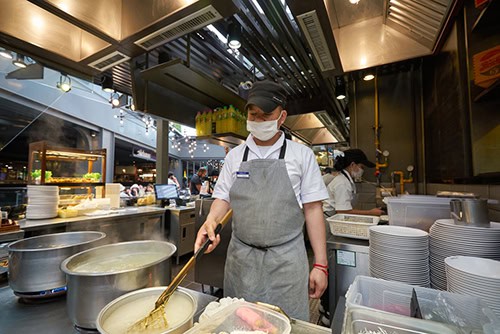Top 12 Hotel Management Software Solutions for 2024
Want to improve the way your hospitality business works? Add hotel management so...

What is a swing shift? The answer might not be as clear-cut as it once was.
Even though the definition has changed over the years, it’s still a useful way for your business to cover transitions between shifts and to reinforce the number of team members on duty when things get busy.
In this article, we discuss the swing shift — both then and now — as well as the benefits your business can enjoy and the best practices that can help make it successful.

The swing shift started as a way for businesses to bridge the gap between the day shift and the night shift.
For example, if a business ran a day shift from 8 a.m. to 4 p.m. and a night shift from 12 a.m. to 8 a.m., it might have implemented a swing shift from 4 p.m. to 12 a.m. so it didn’t have to stop work completely for those eight hours.
While that kind of swing shift still exists, many industries also use this type of flexible schedule to boost employee numbers during peak hours.
For example, a restaurant that’s open from 7 a.m. to 11 p.m. may divide work into two shifts: the day shift (7 a.m. to 3 p.m.) and the evening shift (3 p.m. to 11 p.m.).
If the manager knows the dinner service will be particularly busy, they may include a swing shift from 1 p.m. to 9 p.m. to increase staffing for those eight hours.
Or, if the manager knows that the lunch service will be particularly busy, they may include a swing shift from 10 a.m. to 2 p.m. to boost the number of employees on hand.
It’s important to note here that swing shifts do not have to occur at night, nor do they have to be a full eight hours long.

As we discussed above, the swing shift is a common feature of the food service industry. Some restaurants operate from early in the morning to late at night and need coverage during slow or busy hours. That’s where the swing shift comes in.
Swing shift employees can serve as a supplement for the regular shift workers during the lunch rush and the dinner service, or swing shift employees can fill in gaps between the time when one shift ends and another shift begins.
It really all depends on what the business needs to function effectively. That’s the beauty of the swing shift — it can be customized to fit into any schedule.
Production lines often operate around the clock to meet deadlines and fulfill orders. Running a swing shift in addition to regular shifts ensures continuity and keeps the production process moving.
In addition, the swing shift can provide line coverage so that machines don’t have to be turned off and back on — which can take significant amounts of time — at the end of one shift and the beginning of another shift.
Hospitals, emergency services, and nursing homes rely heavily on swing shifts to fill gaps between the day shift and the night shift (or whatever regular schedules are in place).
Call centers often operate globally and need staff to provide services to different time zones.
Swing shift employees maintain operations and ensure customer inquiries are addressed even during off-peak hours in specific regions.
For businesses that rely on bus drivers, train conductors, airport staff, and delivery personnel, swing shift employees keep everything running smoothly throughout the day and night.
Police officers, firefighters, and security guards often work rotating shifts, with swing shifts ensuring that safety and security are maintained at all times.
Grocery stores are another industry that relies heavily on the swing shift.
During the “off hours,” swing shift team members restock shelves, perform maintenance, and clean the facility so that everything is ready for the next day.

When implemented correctly in a two-shift schedule, a swing shift can help extend operations and enable a business to run 24 hours if necessary.
This may make it possible for that business to:
This type of expanded schedule can be especially useful for call centers, 24-hour restaurants, bakeries, cleaning businesses, coffee shops, and many others.
Many businesses experience surges in customer activity during specific times of the day (or night). As we mentioned, a restaurant may go through a lunch or dinner rush during which they may need more employees on the clock to handle customer demands.
Swing shifts can help managers adjust the number of employees on hand more efficiently and provide the flexibility necessary to handle peak demand followed by a lull in activity.
In some businesses, congestion is a very real issue that managers (and employees) have to deal with.
With too many team members on hand, it may be hard for employees to find space to work, gain access to the tools and supplies they need to complete their tasks, and generally function effectively on the job.
Establishing a swing shift between two main shifts can help reduce congestion and make it easier for team members to do their work successfully.
In some cases, the swing shift may occupy a time with very little customer activity. As a result, reduced outside demands may allow employees working those hours to focus more effectively on their work.
If managers know this to be the case, they can assign more important, time-sensitive, and detail-oriented work to swing-shift team members so that it gets done on time and to the standards set by the business.
In this case, the swing shift may become a tool that businesses can use to leverage human capital for maximum results.
Swing shifts can help reduce overtime costs throughout your business.
While you may have to pay a differential for swing shift work, it’s often less than what you would have to pay in overtime for the same time frame.
For example, you may need a day-shift employee to work a bit more than their scheduled eight hours in order to complete a project. In that case, you would have to pay them time and a half for that extra work.
If that employee makes $10 an hour, you would have to pay them $15 for any overtime hours. That can quickly add up and affect your bottom line.
But, if you have a swing shift in place, you may pay those employees $12 an hour — a significant savings in labor costs when compared to the overtime pay.
So, instead of asking your day shift to work overtime to complete a task, you can have them pass it on to the swing shift to complete on their regular time.

One of the biggest challenges of working the swing shift is the effect it can have on employees’ circadian rhythms — the 24-hour cycle that regulates various physiological processes, including the sleep-wake system, hormone release, and body temperature.
The misalignment of the circadian rhythms — caused by working the swing shift or the night shift for extended periods of time — can lead to an increased risk of various health problems, such as:
What’s more, swing shift workers may struggle with insomnia, chronic fatigue, impaired cognitive function, and decreased alertness.
Unconventional hours can make it difficult for employees to manage personal commitments, schedule necessary appointments, and maintain personal activities that contribute to a fulfilling life.
Personal commitments: Swing shift work can strain family relationships, as it can be difficult to coordinate schedules for meals, childcare, and other family activities. This can be especially challenging for parents with young children or those who need to provide care for elderly relatives.
Necessary appointments: Many businesses operate during traditional daytime hours, making it difficult for swing shift workers to access them. This can include things like doctor’s appointments and banking, which can add extra stress and inconvenience to their lives.
Personal activities: Swing shift hours can leave workers with limited time and energy for hobbies, exercise, and other personal activities. Lack of personal and downtime can lead to feelings of dissatisfaction, disgruntlement, and eventual burnout.
Working the swing shift often clashes with typical social activities — beyond that of the family — making it difficult to participate in social events and maintain relationships.
This difficulty can lead to social isolation and further mental and physical health challenges.
In time, social isolation can exacerbate many of the health issues already mentioned in this section, including depression, anxiety, cognitive decline, stress, cardiovascular problems, weakened immune system, and sleep disturbances (just to name a few).
What’s more, this phenomenon can affect people of all ages, although older adults are often more vulnerable than younger adults.
Fatigue is a very real issue for swing shift workers. Even if they’re getting plenty of sleep during their off hours, the simple fact that they’re working against their body’s natural inclinations (i.e., their circadian rhythms) can lead to a wide variety of fatigue-related issues.
These issues may include:
As you can see, fatigue issues can impact an employee’s mental and physical well-being. The thing is, the symptoms often indicate another issue entirely so that both the individual and doctors alike miss the real problem — lack of good sleep.
Another challenge of the swing shift — this one for managers — is coordination between shifts. Communication between the swing shift and other shifts can be challenging due to the lack of overlap in work hours.
Swing shift workers may have limited access to management and support services when compared to the day shift (and even the night shift).

As you implement and schedule swing shifts, do your best to ensure that the system is fair for all.
Give everyone a chance to work the different shifts on the schedule, and make sure that certain employees don’t get “pigeonholed” into always working the less-desirable swing shifts (if there are any).
The fair distribution of shifts — be they swing, first, second, third, or some other type entirely — can help prevent conflict and hard feelings and the overwork that leads to burnout.
If your business is adding a swing shift to the schedule that has employees working non-standard hours, take the time to train your team about variables like:
Training your employees to handle these (and other) variables in their lives can help them be more effective when asked to work a swing shift that is outside their “normal” work schedule.
If your swing shift runs during non-standard hours — or, if you schedule a split shift to cover two busy periods during the day — make it a point to offer competitive compensation for these time periods.
If an employee feels that they are being paid well for the “inconvenience” of working 4 p.m. to 12 a.m. or working a four-hour shift during the lunch rush and then returning for another four-hour shift during the dinner rush, they’ll be less likely to look elsewhere for a better schedule.
Good lighting can impact employees’ energy level, productivity, and overall mood — especially for those working after the sun goes down.
Lighting that’s too dim may make your employees feel tired and cranky, while lighting that’s too bright may disrupt their body’s natural circadian rhythms and even trigger headaches.
Lighting that is just right for the shift and the space can help your team members stay alert and energized even when they’re on the tail end of a swing shift outside standard work hours.
Depending on how you set them up, swing shifts may contain fewer employees than the shifts around them.
While that may be just fine with some personality types, for others it may lead to isolation and depression.
To combat this issue, plan team-building activities and ice-breakers to engage those who might not have a chance to interact with their co-workers because of the hours they work.

Organizing swing shift hours and keeping your employees working efficiently can be complicated and time-consuming.
Software can help streamline the process and make that job much easier. Advanced apps (like Sling) give you all the tools you’ll need to keep even the most complex shift combinations running as smoothly as possible, including:
Whether you choose to use a swing shift or not, Sling can help you streamline your workforce-management processes and save time that you can then dedicate to building your business.
Swing shift hours are most effective when you have the right number of employees working the right roles at the right time.
Before building any shift — be it swing or otherwise — consider employee competencies so that you have the right skills, experience, and abilities on hand when you need them most.
Keep in mind that the swing shift is often used as a way to adapt to high-traffic, high-demand hours, so scheduling inexperienced team members during these times may make things even more difficult than they would be if the extra employees weren’t on the clock in the first place.
When scheduling a swing shift for your business, build in some flexibility to help the team members who work those hours maintain a healthy work-life balance.
This often involves including systems that make requesting time off, swapping shifts, and finding substitutes as simple and straightforward as possible.
Within the swing shift itself — and all shifts, for that matter — provide enough breaks to keep team members happy, positive, and energized.
Supporting work-life balance in this way makes it easier for everyone involved to focus on serving your customers better (or doing their best work) when they’re on the clock.
Depending on how you build your schedule, your swing shift hours may extend into non-standard work times. Or, you may set up the swing shift as a split shift that covers two busy periods during the day (e.g., the lunch shift and the dinner shift).
Whatever the case, consider offering a shift differential to those who work these hours as a way to make the irregular schedule more attractive.
If an employee feels that they are being paid well to work a swing shift, they’ll be more motivated to work those odd hours.
As you consider the best way to use the swing shift in your business (and whom to schedule there), give everyone the opportunity to work all shifts.
We talked about keeping everything as fair as possible earlier in the article, and this is an extension of that. Avoid lopsided scheduling practices that build conflict, animosity, and hard feelings between coworkers.
In some cases, this may mean setting up a rotating split swing shift. How does such a schedule work?
In a restaurant, Employee A would work the morning shift (7:00 a.m. to 3:00 p.m.) for one week, the evening shift (3:00 p.m. to 11:00 p.m.) for one week, and the split swing shift (10:00 a.m. to 2:00 p.m. and 5:00 p.m. to 9:00 p.m.) for one week.
Keep in mind that this is just one way to make use of the swing shift – there are many other ways to incorporate these hours into your schedule so that everything is fair and no one gets overworked or underutilized in the process.
At least once a year, analyze the swing shift(s) — and, indeed, the whole schedule — to minimize the negative impacts on both your business and your team members.
In many cases, this means taking the time to monitor and track a variety of data points, such as:
Use what you find to improve the way you schedule your team and the way you operate your business.

Regardless of how many swing shifts you use or how complicated your shift scheduling is, Sling can help you keep everything organized and running smoothly with a wide range of employee-management tools, including:
Try the app for free to see why Sling is the scheduling and workforce-management solution for businesses of all types and sizes. And, for more free resources to help you manage your swing shifts, organize and schedule your team, and track and calculate labor costs, visit GetSling.com.
This content is for informational purposes and is not intended as legal, tax, HR, or any other professional advice. Please contact an attorney or other professional for specific advice.
See Here For Last Updated Dates: Link
Schedule faster, communicate better, get things done.